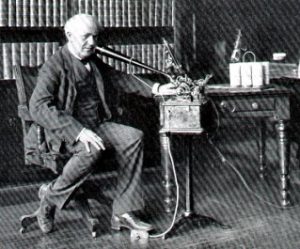Most writers type the first drafts of their stories. A few, like me, hand-write their first drafts. Perhaps you’d like to try a third way…dictating your stories.
That’s right. Forget the keyboard or pen. Just speak your story into a recording device.
Reasons
Why might you want to do that? On her site, Cindy Grigg offers 13 compelling reasons. I was struck by the first one, speed. After getting used to dictating stories, many writers find they can crank out their first draft prose much faster. That saves time and makes them more prolific.

You might also benefit from the increased mobility. Speaking into your handheld digital voice recorder or cellphone, you’re freed from the shackles of your desk and chair and the need to have two hands on a keyboard. You can wander around the house, around the neighborhood, through the nearest park. The walking (1) keeps you healthier, (2) avoids any chance of eye strain or repetitive motion injuries, and (3) provides more varied stimulation for your senses that you can work into your fiction.
I think Grigg is onto something, too, in listing strengthened storytelling voice as another advantage. I’ve advised writers to read near-final drafts aloud before submitting them as a way of improving readability. Why not speak it aloud from the start?
Further, when dictating, it’s easier to turn off your inner editor. I’ve mentioned before how important that is when creating your first draft.
Methods
The objective is to get words from your head into word processor text. When you type on a keyboard, the process is direct. If you write by hand, there’s another step when you transcribe from your handwritten pages and type it on the keyboard.
For dictation methods, you can speak into your computer microphone or your cellphone and make use of speech recognition software to convert your words directly into digital text.
Or you can use a digital voice recorder or cell phone to record your voice into a .wav or MP3 format. Then you’ll go through a second step, to transcribe the words from one of those formats into the word processor. You can do that by (1) listening and typing them yourself, (2) paying someone else to do that, like Kevin J. Anderson does, or (3) playing your voice back into your computer’s speech recognition software.
The Adjustment
Shifting from typing or handwriting to dictation takes some getting used to. Be prepared for some discomfort at first. According to Monica Leonelle, in her interview with Joanna Penn, the shift can take a few months before you’re used to it.
My Experience
A few years ago, I tried Dragon NaturallySpeaking speech recognition software. I was able to train the Dragon, but I couldn’t get comfortable speaking my first drafts that way. I returned to writing by hand.
I’m having second thoughts about dictation now. For years, I’ve adapted my fiction writing to accommodate my day job. I’ll be retiring soon, so my writing habits will have to change. Perhaps writing aloud will prove to be the new optimum method for—
Poseidon’s Scribe
